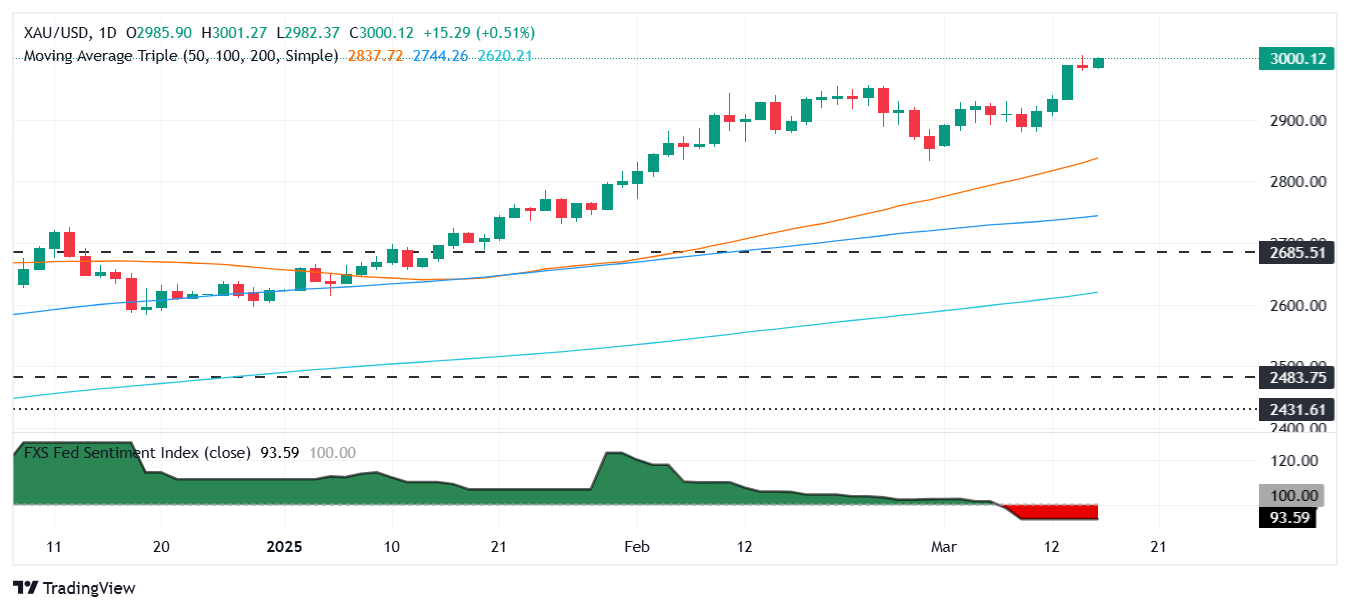- Gold trades at $2,999, rising 0.40% as traders brace for the Federal Reserve’s policy decision on Wednesday.
- US Retail Sales disappoint, while manufacturing activity plummets, fueling recession fears and boosting rate cut expectations.
- Weaker US Dollar and lower Treasury yields support bullion with the 10-year T-note yield slipping to 4.308%.
Gold price rises on Monday late in the North American session, hoover near the $3,000 mark for the second straight day, after data from the United States (US) shows the economy is cooling. The XAU/USD trades at $2,999, up over 0.40%.
Risk appetite improved as reflected by US equities with traders shrugging off a weak US Retail Sales report for February. In addition, the New York Fed Empire State Manufacturing Index plunged, sparking fears that the economy might be tipped into a recession.
Therefore, money market futures are pricing in 64 basis points (bps) of easing by the Federal Reserve (Fed) toward the end of the year.
The main event during the week is the Fed’s monetary policy decision on Wednesday, followed by Fed Chair Jerome Powell's press conference and the release of the Summary of Economic Projections (SEP).
In the meantime, Bullion continued to climb, sponsored by falling US Treasury yields and a weaker US Dollar. The US 10-year T-note yield dropped one basis point to 4.308%. At the same time, the US Dollar Index (DXY), which tracks the buck’s performance against a basket of six currencies, fell 0.35% to 103.37.
Daily digest market movers: Gold price is unfazed by high US real yields, extends rally
- US real yields, as measured by the US 10-year Treasury Inflation-Protected Securities (TIPS) yield, which correlates inversely to Gold prices, rose four bps to 2.00% via Reuters.
- February US Retail Sales improved, increasing by 0.2% MoM, missing forecasts of 0.6%, up from January’s -1.2% plunge.
- The New York Fed showed that manufacturing activity dipped from 5.7 to -20, with input prices increasing to their highest level in over two years.
- Despite recent cooler-than-expected inflation data, economists caution that tariffs on US imports could lead to a renewed inflationary uptick in the coming months.
- UBS projects Gold to reach $3,200 in 2025. “With the price now reaching our long-held target of $3,000/oz, the main question is whether the rally will continue. We think so, as long as policy risks and an intensifying trade conflict continue to spur safe-haven demand,” UBS said.
XAU/USD technical outlook: Gold price struggles to hold above $3,000
Gold prices remain near record highs yet fail to advance sharply as the Relative Strength Index (RSI) has exited overbought territory, opening the door for a pullback. It should be said there is a negative divergence with XAU/USD reaching higher prices, while the RSI failed to print new peaks.
Nevertheless, if XAU/USD clears the previous record high of $3,004, the next resistance would be $3,050 and $3,100. Conversely, a daily close below $3,000 could sponsor a retracement toward the February 20 daily high at $2,954, followed by the $2,900 mark.
Risk sentiment FAQs
In the world of financial jargon the two widely used terms “risk-on” and “risk off'' refer to the level of risk that investors are willing to stomach during the period referenced. In a “risk-on” market, investors are optimistic about the future and more willing to buy risky assets. In a “risk-off” market investors start to ‘play it safe’ because they are worried about the future, and therefore buy less risky assets that are more certain of bringing a return, even if it is relatively modest.
Typically, during periods of “risk-on”, stock markets will rise, most commodities – except Gold – will also gain in value, since they benefit from a positive growth outlook. The currencies of nations that are heavy commodity exporters strengthen because of increased demand, and Cryptocurrencies rise. In a “risk-off” market, Bonds go up – especially major government Bonds – Gold shines, and safe-haven currencies such as the Japanese Yen, Swiss Franc and US Dollar all benefit.
The Australian Dollar (AUD), the Canadian Dollar (CAD), the New Zealand Dollar (NZD) and minor FX like the Ruble (RUB) and the South African Rand (ZAR), all tend to rise in markets that are “risk-on”. This is because the economies of these currencies are heavily reliant on commodity exports for growth, and commodities tend to rise in price during risk-on periods. This is because investors foresee greater demand for raw materials in the future due to heightened economic activity.
The major currencies that tend to rise during periods of “risk-off” are the US Dollar (USD), the Japanese Yen (JPY) and the Swiss Franc (CHF). The US Dollar, because it is the world’s reserve currency, and because in times of crisis investors buy US government debt, which is seen as safe because the largest economy in the world is unlikely to default. The Yen, from increased demand for Japanese government bonds, because a high proportion are held by domestic investors who are unlikely to dump them – even in a crisis. The Swiss Franc, because strict Swiss banking laws offer investors enhanced capital protection.
Information on these pages contains forward-looking statements that involve risks and uncertainties. Markets and instruments profiled on this page are for informational purposes only and should not in any way come across as a recommendation to buy or sell in these assets. You should do your own thorough research before making any investment decisions. FXStreet does not in any way guarantee that this information is free from mistakes, errors, or material misstatements. It also does not guarantee that this information is of a timely nature. Investing in Open Markets involves a great deal of risk, including the loss of all or a portion of your investment, as well as emotional distress. All risks, losses and costs associated with investing, including total loss of principal, are your responsibility. The views and opinions expressed in this article are those of the authors and do not necessarily reflect the official policy or position of FXStreet nor its advertisers. The author will not be held responsible for information that is found at the end of links posted on this page.
If not otherwise explicitly mentioned in the body of the article, at the time of writing, the author has no position in any stock mentioned in this article and no business relationship with any company mentioned. The author has not received compensation for writing this article, other than from FXStreet.
FXStreet and the author do not provide personalized recommendations. The author makes no representations as to the accuracy, completeness, or suitability of this information. FXStreet and the author will not be liable for any errors, omissions or any losses, injuries or damages arising from this information and its display or use. Errors and omissions excepted.
The author and FXStreet are not registered investment advisors and nothing in this article is intended to be investment advice.
Recommended content
Editors’ Picks

Gold falls amid a possible de-escalation of US-China tensions Premium
Gold pulled back from its all-time high of $3,500 per troy ounce reached earlier on Tuesday, as a resurgent US Dollar and signs of easing tensions in the US–China trade dispute appeared to draw sellers back into the market.

EUR/USD retreats to daily lows near 1.1440
EUR/USD loses the grip and retreats to the 1.1440 zone as the Greenback’s rebound now gathers extra steam, particulalry after some positive headlines pointing to mitigating trade concerns on the US-China front on Tuesday.

GBP/USD deflates to weekly lows near 1.3350
GBP/USD loses further momentum and recedes to the 1.3350 zone on Tuesday, or two-day troughs, all in response to the frmer tone in the US Dollar and encouraging news from the US-China trade scenario.

3% of Bitcoin supply in control of firms with BTC on balance sheets: The good, bad and ugly
Bitcoin disappointed traders with lackluster performance in 2025, hitting the $100,000 milestone and consolidating under the milestone thereafter. Bitcoin rallied past $88,000 early on Monday, the dominant token eyes the $90,000 level.

Five fundamentals for the week: Traders confront the trade war, important surveys, key Fed speech Premium
Will the US strike a trade deal with Japan? That would be positive progress. However, recent developments are not that positive, and there's only one certainty: headlines will dominate markets. Fresh US economic data is also of interest.

The Best brokers to trade EUR/USD
SPONSORED Discover the top brokers for trading EUR/USD in 2025. Our list features brokers with competitive spreads, fast execution, and powerful platforms. Whether you're a beginner or an expert, find the right partner to navigate the dynamic Forex market.




